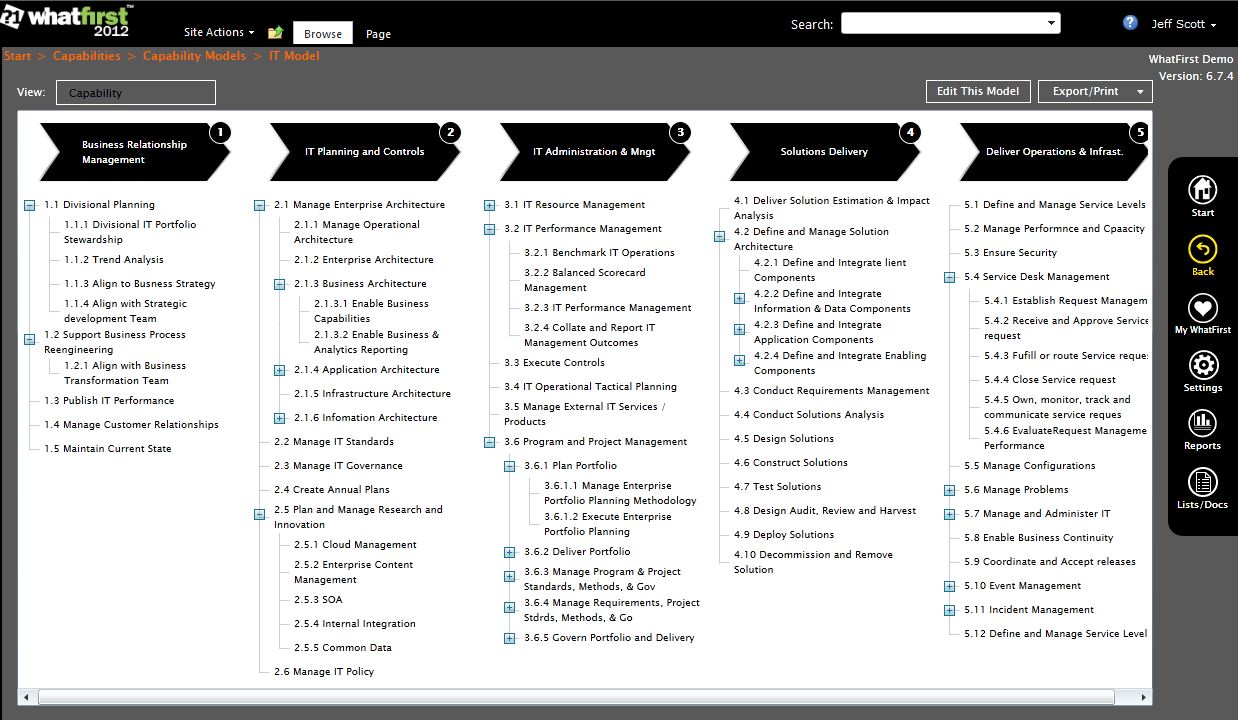http://thebusinessarchitect.accelare.com/2013/03/04/capabilities-demystified-part-1/

Defining Business Capabilities
Business capabilities have quickly become the core element of most business architecture models. Their appeal is largely driven by three factors. First, business leaders at all levels find capabilities an appealing and useful way to think about growing their organization’s impact. Second, capabilities are versatile, easily applied to high level strategic activities such as scenario planning or outsourcing investigations as well as lower level operational analysis. And third, capabilities can be linked to other elements in the planning process such as people, process, technology, and information. However, capabilities remain poorly understood and often confused with processes, functions, or services. This series of posts will take a deep look at capabilities from different perspectives.
Business Capability Definition
A business capability (or simply capability) describes a unique, collective organizational ability that can be applied to achieve a specific outcome. It describes what an organization is capable of doing, but not how it does it. A capability model describes the complete set of capabilities an organization requires to execute its business model or fulfill its mission. An easy way to grasp the concept is to think about capabilities as organizational level skills imbedded in people, process, and/or technology.
Capability Attributes
Each capability is unique. A capability is a fundamental element of the organization and as such is clearly different from other capabilities. A capability might be applied throughout the organization and may be applied in different ways to affect different outcomes but it is still a single capability.
Capabilities are stable. Well-defined capabilities rarely change. They provide a much more stable view of organizations than do projects, processes, applications, or even strategies. Capabilities only change when there is a significant shift in the underlying business model or mission which might occur through a business transformation initiative or in conjunction with a merger or acquisition. This stability is a key part of their appeal.
Capabilities are abstracted from the organizational model. Capability models are not just a simple restatement of the enterprise’s organizational model. They are organizationally neutral which means that changes in the organizational structure don’t require a change in the capability model. In simple organizations, the capability model may indeed look similar to the corporate organizational structure because organizations are typically built around common skills. But more complex organizations have many capabilities that appear in multiple functional groups.
Capabilities can be defined for any organizational unit. Though most architects think of capabilities at the enterprise level, every organization, large or small, has a set of capabilities it applies to fulfill its mission. Since capabilities represent the organization’s leaders’ interest, each organization will have a unique combination of capabilities not seen in the rest of the organization.
Individual capabilities do not have a purpose. Since capabilities represent what an organization can do and not what it actually does they can be viewed as potential. This means capabilities can be applied in multiple ways, for different purposes. This also means they must be assessed in terms of their application – measured on a fit-for-purpose scale not a maturity scale.
Capability Corollaries
First and foremost capabilities capture the organization’s interest. The primary value in defining capabilities lies in their ability to create new insight and perspective for business leaders. To accomplish this, capabilities must be defined in a way that resonates with business executives’ thought process. Creating meaning is the goal. Coherence and completeness are not as important as resonating with business thinking.
Latent capabilities define an organization’s bench strength. A capability need not be employed to exist. Latent capabilities refer to the abilities an organization has but does not apply. These capabilities rarely show up in a capability model but can be important to strategy development. Defined capabilities might also have untapped potential in that the organization is not applying the full breadth of the capability.
Capability models are not hierarchical. Though capabilities can often be decomposed into lower level capabilities, the model is not entirely hierarchical. A lower level organization’s capability model cannot be derived from the higher level model. Since capabilities represent the organization’s leaders’ interest, each organization typically has a unique set of capabilities not seen in other organizational units as well as a set that is common with other organizations. Therefore, each organization within a single company typically has a unique capability map.
Capability models provide a powerful tool for facilitating strategic and operational dialog across disparate organizations, providing a foundation for objective analysis, and understanding how and where value is created. The next post in this series will look at how capabilities and capability models are constructed.
No hay comentarios:
Publicar un comentario